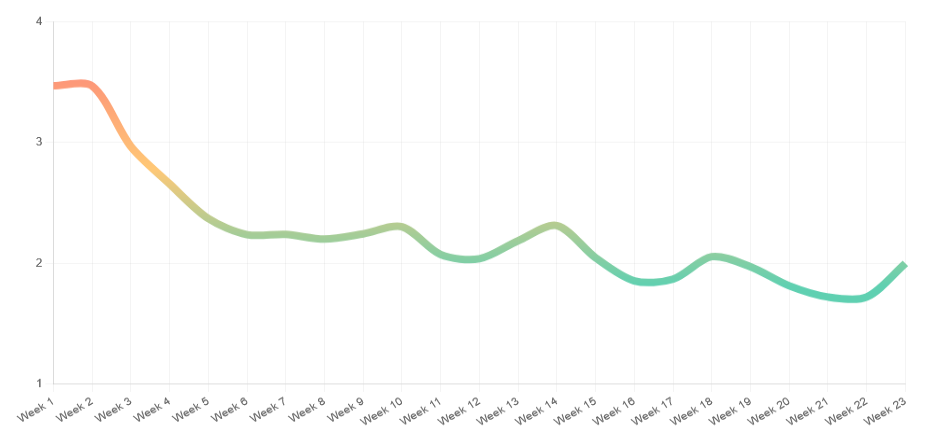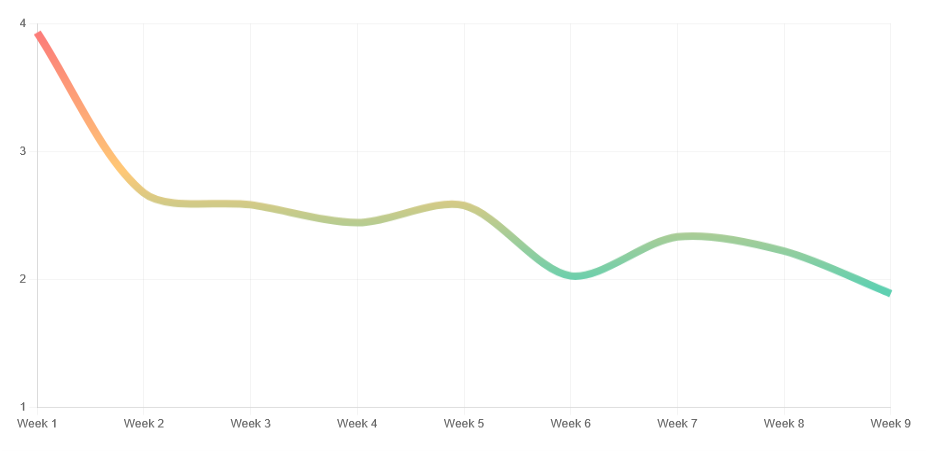Bia Impact Report - Fall 2025
Twice a year, we publish our Bia Impact Report to share how Bia is helping people face their fears. Our goal is to be transparent about what we're seeing, highlight progress, and identify where we can keep improving. The following results are based on anonymized, aggregated data from thousands of Bia users worldwide. We are excited to report consistent and significant improvements across Bia users.
Adult Users: Phobia Severity Over Time

Average phobia severity scores per user, per active week.
Children Users: Phobia Severity Over Time

Average phobia severity scores per user, per active week.
Diving In
How We Measure Severity
Bia tracks user progress with validated clinical scales tailored to their journey. For phobias, we use the Severity Measure for Specific Phobia. For contamination OCD, we use the Yale-Brown Obsessive Compulsive Scale (Y-BOCS).
Every user begins with a baseline severity score, and is prompted to update their severity every two weeks or at specific checkpoints.
Results
On average, Bia users show a steady reduction in severity. Timelines differ slightly between adult and children users:
- Adults: Adults report significant improvement within the first six weeks, with continued but slower gains in the following months. Adults frequently take breaks of over 30 days during their journey.
- Children: Children report faster recovery timelines, with some reporting noticeable improvements within the first few days. Children complete more exercises in less time and take fewer breaks. We attribute this likely to the fact they have a care taker encouraging practice.
Averages don't always tell the full story. Individual experiences can very widely. We use these insights to update our exposure hierarchies, refine our real-time adaptive exposure engine, and expand our interactive therapy toolbox. We are always striving to make Bia more effective and easier to use.
Looking Ahead
Over the few months we will continue to grow and improve Bia in a few key ways:
- This fall we launched Bia for Schools, a specialized set of modules designed to help anxious children get back to attending school confidently and consistently. We are looking for a school to partner with as a publishable case study.
- Bia is designed to be an extension of therapy, not a replacement. We continue to expand our provider portal functionality to give providers the tools they need to start, deliver, and adapt their ERP treatment for improved client outcomes.
- Our academic collaboration with the University of Utah is nearing completion and we are excited to publish the first data on the effectiveness of Bia, the first self-guided tool for exposure practice.
Our vision remains the same: to make recovery from fear and anxiety accessible, measurable, and supported at every step.
Summary
Thousands of people have used Bia to face their fears. The data shows a clear trend: with continued use, severity scores decrease. We are excited to continue improving and helping people around the world take their life back from fear.
Questions, feedback, or ideas? We'd love to hear from you.
How it Works
- Learn the how and why of your phobia. Your phobia is not your fault.
- Personalize your journey and set your goals.
- Learn researched techniques for overcoming phobia.
- Practice new skills in a safe environment.
- Track your progress on lessons, exercises, and major milestones.
- No tricks, traps, or surprises of any kind.

Get Started
Bia is your place to learn and practice. Just like a musician practices at home before they play on stage, Bia helps you practice for life. Start today, progress at your own pace, and conquer your phobia.
Mission
Our mission at Bia is to help you overcome phobia by providing a safe place to learn and practice researched recovery techniques.
Frequently Asked Questions
Is it possible to overcome phobia?
Yes. Research shows, recovery from phobia is possible. You don't have to settle for life with phobia.
What does it mean to overcome a phobia?
Imagine a life where phobia does not influence your decisions. Where you can go where you want, eat what you want, and do what you want without anxiety, or fear.
Is Bia a replacement for therapy?
No. Bia is a personalized guided tool for learning about and practicing exposure. It can be used with, or without, the aide of a therapist, but Bia does not replace the use of a traditional therapist.
Is Bia HIPAA Compliant?
Yes. Bia is HIPAA compliant.
I am nervous to try it.
We built Bia to lower the barrier to the path of recovery. Bia never tricks, traps, or forces you in any way. The journey is built of small, incremental steps. You control the pace and order of your journey.
How long does it take?
Individual sessions on Bia are short and take 5 to 15 minutes. Bia builds a personalized step-by-step journey based on your unique needs, so completing the full journey is different for everyone. Typically, a journey includes over 55 exercises and 19 lessons across 9 milestones.
How much does it cost?
Bia is free to try. A subscription is required to unlock your full journey.
Subscriptions help pay for the development of Bia including server costs, content and software development, translation efforts to support more languages, and more. New features and content are added regularly.
Does it use AI?
No
Is Bia researched?
Bia is based on researched techniques, but is itself not researched. Read more about the research here. We are actively seeking academic partnerships to research the effectiveness of Bia. Please contact us with any research interest.
What do you do with my data?
Bia never shares your data with third parties. You can view and delete your data at anytime. Good privacy is simple, you own your data.
I have another question.
Please, contact us and we will get back to you as soon as possible.
Other resources.
Here are some other resources that might be helpful:



